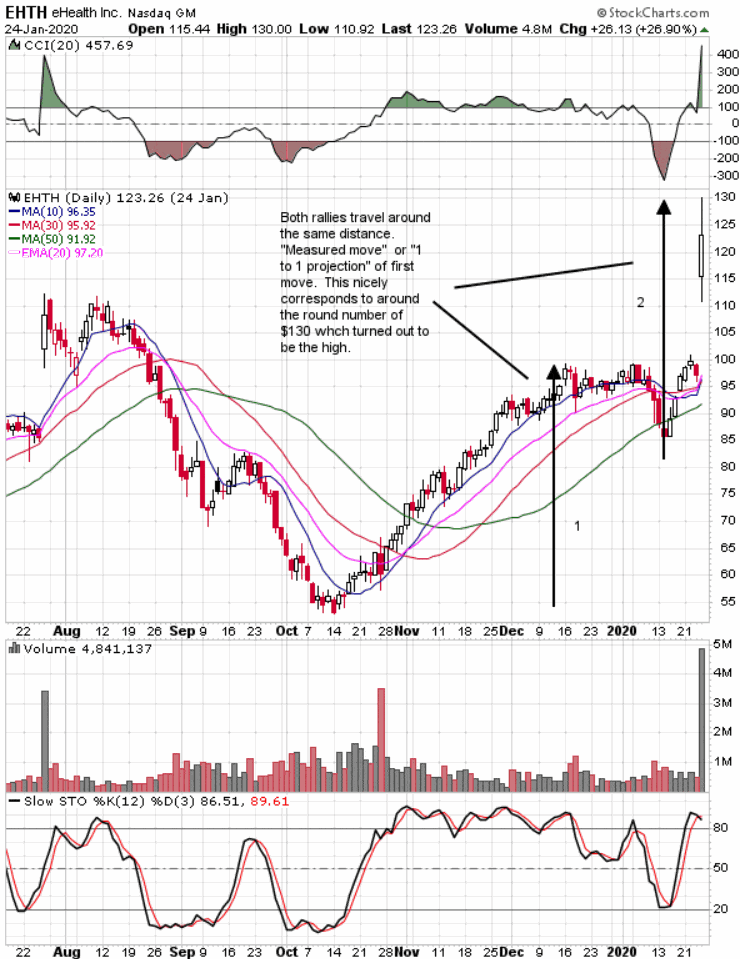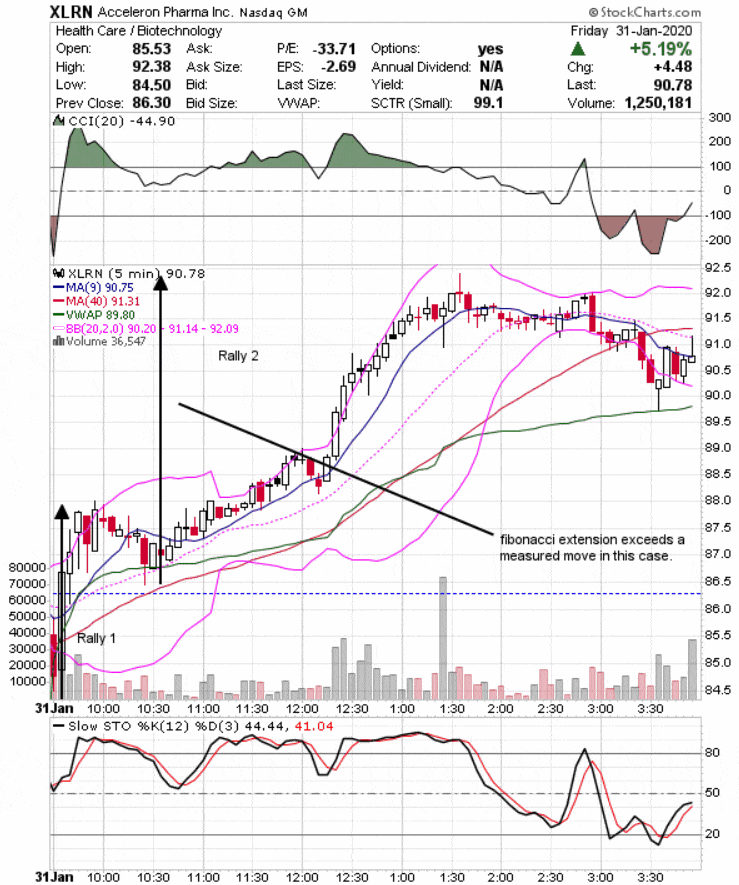Trading Earnings Pre-Announcements and Using Fibonacci
The earnings eruptions strategy has been a go to technique for us to profit on big earnings beats over the past few years.
Last quarter, a couple good examples were CDLX and QRVO among others which made enormous moves very quickly after reaching the technical entry point in the strategy.
But what do we do if the company pre-announces earnings and sales before the earnings date?
Our Secret for Trading Earnings Pre-announcements
Well, here is one of the secrets.
Wait for it……..
We basically play the trade just like a blowout earnings report!
Essentially the company is just giving you a close approximation of the results ahead of the earnings date.
They report the numbers after hours and either the stock, earnings report, long-term chart and pre-market pattern meet our stringent requirements in the earnings eruptions strategy. Or not.
One of the benefits of getting the pre-announcement is that they often give you the important numbers and guidance without a conference call in many cases. So you usually do not have to deal with a conference call scheduled to start while you are in the trade in the morning.
Plus, you do not have a full earnings release to go through – searching for any “gotchas” like signs of eroding margins.
This quarter the market Gods smiled down on us by giving us EHTH and CDLX at the very beginning of earnings season. Both CDLX and EHTH had massive beat and raise quarters, raised guidance a lot and set up the pre-market pattern we look for within great long-term trends on a daily chart.
Both stocks reached the technical entry point in the strategy and cruised another 10% to 20% within hours. They played just like a regular big beat and raise on a top growth stock.
Both stocks barely pulled back below the technical entry point after triggering a trade which is key to the strategy. Our strategies are intended to give us high percentage trades while using a tight stop-loss with big upside potential.
How We Use Fibonacci, Measured Moves and Confluence
Some traders use fibonacci tools to form the basis of their trading strategies. For us, its one of the tools we use but we focus more on trend analysis, chart patterns, catalysts and fundamental quantitative analysis as well.
So we apply fibonacci methods in more of a subordinate role on top growth stocks and UPOD stocks in the best long-term trends, good consolidation patterns with strong fundamental factors all trending in the same direction.
However, fibonacci tools are valuable on some trades. Here is an example of how we used fibonacci confluence and measured moves last Friday on EHTH.
In a prior blog post we talked about how the best bullish technical pattern is actually multiple bullish chart patterns on different time-frames. This is also sometimes referred to as “confluence”. The same principle can be applied to “measured moves” – a fibonacci principle.
Measured Moves
A measured move or “one to one projection” of a first move is just using the historical tendencies of a stock to our advantage. Its basically taking the first move (higher in this case) and projecting the length or size of the first move to the start of the second move to come up with a target.
So lets say a stock moves from $30 to $50 and then pulls back to $40. It then starts a second wave higher after pulling back to the $40 mark.
You would project the $20 initial move higher from $40 to come up with a $60 price target. This is a measured move and fibonacci extension of the first move higher.
An example of fibonacci confluence is when this projection of a first move on different time-frames gives you around the same price target.
Lets take a look at how we used this last Friday on EHTH to sell a lot of our shares near $130.
To avoid confusion, this move occurred due to the enormous catalyst and not because of some magic fibonacci extension. The extensions just help us to come up with a reasonable first sell target.
The first image below shows the daily chart of EHTH and the larger A-B-C up pattern and measured move.

Larger measured move on daily chart
The first rally went from October to December where the price increased around $45 or so. The price then pulled back in mid-January before rallying after the enormous pre-announced earnings beat and raise.
So that is the measured move developing on a daily chart over the past few months. Now here is another A-B-C up pattern and measured move that developed intraday on a 5 minute chart.
Measured move on 5 minute chart intraday. A 2nd measured move with the same target results in confluence.
Again the distance traveled during the first rally is projected from the low on the pullback after it starts to move out of the consolidation. The earnings eruptions strategy goes over a great secondary entry point in the consolidation after the first wave higher early in the day.
We jumped in on this trade quickly after the open using the earnings eruptions strategy with a large position.
Once we noted the measured move target almost exactly matched the fibonacci extension on the daily chart, we began to target just below $130 for taking a good portion of our profits after getting in around $118.
Now with this kind of enormous catalyst, we would not take everything off at that point. However, we took a lot off at that point for a big profit and stopped the remainder a little above our entry. A real nice trade.
Now are we going to bet after a retracement of the first move in mid-January that the stock will go to $130? Probably not.
This is because if the earnings news is bad, the stock could easily go back to $45 or lower instead of $130.
You usually need a strong catalyst of some kind to push a stock that much higher that quickly. Its not going to move like that just because it had a 38.2% retracement and shows signs of a rebound.
Sure, maybe a small percentage will make that kind of move after the retracement, but you could wait months or years for it. And the losing trades will eat away at the profits.
We would rather take 5% to 10% in a day, then stop the remainder at our entry, and move on to the next higher percentage trade with huge upside potential that will likely come up in the days ahead. If the stock breaks the high again the next day, we will play a follow-on move which is another higher percentage trade or sell the rest of our shares if the stop held after it goes into new highs again the next day.
The problem with fibonacci trading
One of the problems with solely relying on fibonacci principles is that the retracements and extensions all have multiple levels where the stock may go to. It could be a 50% retracement, 61.8% retracement, 38.2% retracement or many others or none of them.
Some will say that the 61.8% retracement or 50% retracement is best. In our experience on the best stocks, the smaller the retracement, the better.
Now a measured move could easily turn into a 150% extension of the first move up or 161.8% extension or 50% extension. So it just gives you some levels to keep in mind. When you have confluence on different time-frames its a little more meaningful.
Here is another example of a day trade we took yesterday after a high tight flag breakout on Thursday. We got in on the first pullback after it started to move higher again around $87.75 on day 2 after the breakout. We sold the final shares on that day trade around $92. This was around a 161.8% projection of the first move earlier in the day.
If market volatility did not increase so much late in the week, we would have held a lot of the position longer.

Larger fibonacci extension intraday on a hot stock – XLRN
The reason we took the trade though was the underlying trend to begin with. Not because it had some magical fibonacci retracement. That just does not work in our experience.
We also know from experience and back-testing that these extremely bullish patterns tend to have strong 2nd day moves as well if the first day goes well. From that point, we started to look for a good reversal pattern (1-2-3 trend change or bullish inverted J) intraday and give it a shot while stopping below the prior swing low.
So we don’t rely on fibonacci techniques when trading. Its just another tool to use or keep in mind.
The main factors that made both trades a success were the huge trend going into a strong consolidation, catalyst, pre-market pattern, long-term trend and the technical, quantitative and fundamental factors of the stock.
So its the confluence of these and other factors that we are looking for in an ideal trading opportunity.
Big Earnings Season just Getting Started
Over the past few months we have seen a lot of big moves on top stocks featured to clients. AMD, PAYC, PCTY, EVER and numerous others have made 10% to 50% or more moves higher within a few hours to several weeks.
The market is pulling back right now which will set up some great opportunities in the weeks ahead. After a market pullback is often a great time to get started.
And during earnings season, our go to strategy is on the biggest earnings gaps.
A strategy with a very high win rate while using a tight stop-loss when qualified using our strategy rules.
Learn More about the Earnings Eruptions Strategy







